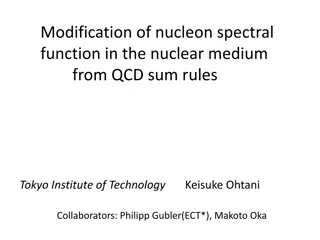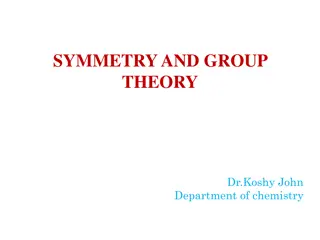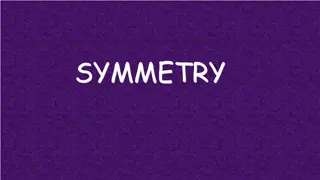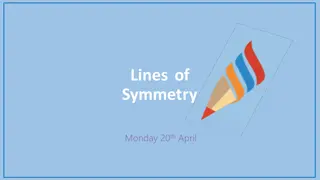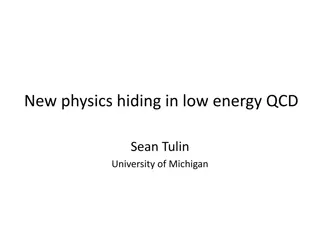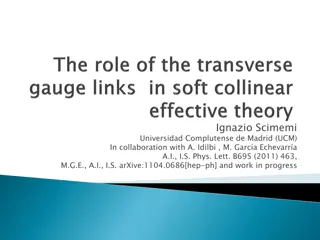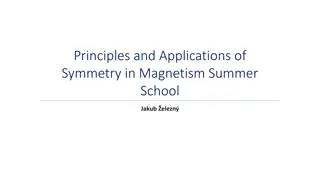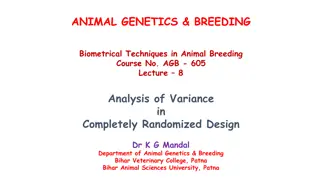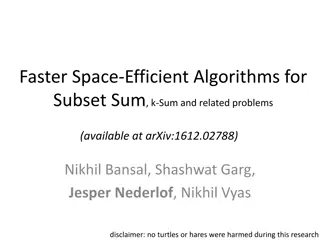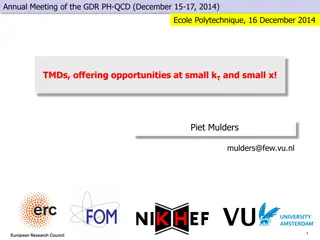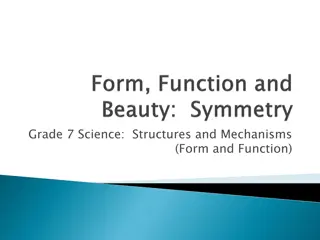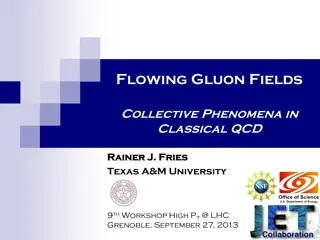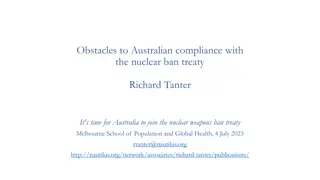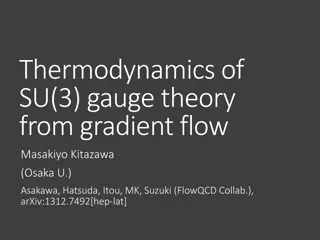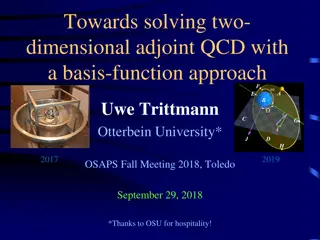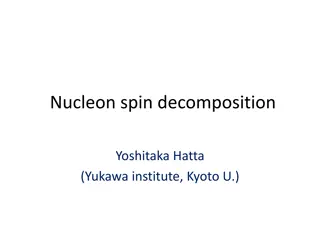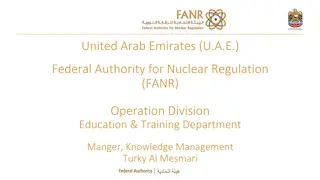Exploring Nuclear Symmetry Energy with QCD Sum Rule
This study delves into the concept of nuclear symmetry energy through the lens of QCD Sum Rule, discussing its implications in Rare Isotope Accelerator Plan and nucleon-nucleus scattering. Utilizing mean field approximation and Borel transformation, the research aims to understand asymmetric nuclear matter within the framework of QCD degree of freedom.
Download Presentation

Please find below an Image/Link to download the presentation.
The content on the website is provided AS IS for your information and personal use only. It may not be sold, licensed, or shared on other websites without obtaining consent from the author. Download presentation by click this link. If you encounter any issues during the download, it is possible that the publisher has removed the file from their server.
E N D
Presentation Transcript
Nuclear Symmetry Energy from QCD Sum Rule Phys. Rev. C87 (2013) 015204 (arXiv:1209.0080) Saga-Yonsei Workshop January 17, 2014 Kie Sang JEONG Su Houng LEE (Theoretical Nuclear and Hadron Physics Group) Yonsei University 1
Motivation 1 RAON plan Rare Isotope Accelerator Plan (Quoted from Physics Today November 2008) Nuclear Symmetry Energy plays a key role in Rare Isotope and Neutron Star study 2
Motivation 2 RMFT QCD SR Dirac phenomenology of nucleon-nucleus scattering Strong vector repulsion Re V>0 Strong scalar attraction Re S<0 Dirac optical potential This tendency naturally comes from RMFT QHD model, DBHF approximation etc. 3
Motivation 2 RMFT QCD SR For symmetric nuclear matter, this large cancelation mechanism between the self energies can be understood in QCD degree of freedom Could asymmetric nuclear matter be understood in QCD degree of freedom? Physical Review C 49, 464 (1993) (Thomas Cohen et al. (1992)) We applied QCD Sum Rule to asymmetric nuclear matter 4
Mean field approximation Nuclear Symmetry Energy in infinite nuclear matter Quasi-nucleon on the asymmetric Fermi sea (Up to linear density order) RMF type nucleon propagator 5
QCD Sum Rule Correlation function is medium four-velocity Ioffe s interpolating field for proton Energy dispersion relation Contains all possible hadronic resonance states in QCD degree of freedom Phenomenological ansatz in hadronic d.o.f. Equating both sides, nucleon self energies can be expressed in QCD degree of freedom 6
QCD Sum Rule At short distance, Wilson coefficient can be obtained by perturbative calculation Contains all non-perturbative contribution For example, (These figures are quoted from Ph.D. thesis of Thomas Hilger) Linear density approximation 7
Borel transformation To emphasize quasi-nucleon pole contribution For OPE side For phenomenological side, equivalent weight function has been used Borel transformed invariants With continuum correction 8
Sum Rule analysis up to dimension 5 Nuclear Symmetry Energy Main ingredient? Nuclear Symmetry Energy is ~40 MeV and do not strongly depend on Consistency with previous studies in order of magnitude Mainly consists of `potential like part -> Phenomenological ansatz works well 9
4-quark Operator Product Expansion By using Fierz rearrangement we have found the exact four- quark operators in the nucleon sum rule With constraint from `zero identity and assumed P, T symmetry of medium ground state Among these, except for all proton expectation value of twist-4 operators can be estimated from experiment (DIS) , 10
Twist-4 operator from DIS data (SHL et al., Physics Letter B 312 (1993) 351-357) Where, Ku, Kd and Kud are From these result 11
Twist-4 operator from DIS data Table for Twist-4 matrix elements for the nucleon SR Only first set gives physically meaningful results 12
Nuclear Symmetry Energy with Twist-4 ops. Iso-vector scalar / vector decomposition of Nuclear Symmetry Energy RMFT result Iso-vector meson exchange Vector meson exchange -> Repulsive Scalar meson exchange -> Attractive (V.Baran, et al. Physics Reports 410 (2005) 335 466) Esym(GeV) In the result without twist-4 ops., both self energies give weak contribution Which part gives reduction to Symmetry energy in our QCD sum rule? exchange channel in RMFT Contribution of Twist-4 Ops. mimics rho-delta meson 13
DIS data will be improved Table for Twist-4 matrix elements has some uncertainty Jefferson Lab has a plan for accelerator upgrade This plan will lead to more precise structure functions for Twist-4 matrix elements 14
At extremely high density? Model predictions for Nuclear Symmetry Energy at extreme condition The origin of nuclear reaction in asymmetric matter may comes from Multi-quark operators like Twist-4 ops. At high density, phase of nuclear matter may become quark phase, and the dominating dynamics will be QCD We may make na ve guess that this kind of prediction for dense condition might be justified by QCD via studying multi-quark operators at high density C. Xu, Bao-an Li, Lie-wen Chen, Che Ming Ko. / Nuclear Physics A 865 (2011) 1 16 Figure 3 of J.Phys. G 37 (2010) 083101 Di Toro et. al. 15
Conclusion We have successfully reproduced numerical value of the Nuclear Symmetry Energy of previous studies and found exact four-quark operators in the nucleon sum rule. Twist-4 matrix elements give important contribution to Nuclear Symmetry Energy. Its contribution mimics the iso-vector meson exchange channel in recent RMFT models. Our study shows that Nuclear Symmetry Energy can be understood via QCD, its fundamental origin may comes from quark and gluon degrees of freedom. Extremely high density behavior remains unclear, but this also might be understood via QCD. Related study is now in progress. 16
In-medium condensate in asymmetric matter Twist decomposition of 2-quark condensates Twist-3 Twist-2 Ratio factor for twist-2 operators can be obtained from matrix elements Distribution function for quarks and anti-quarks in proton 18
In-medium condensate in asymmetric matter Ratio factor for twist-3 operators This relation can be estimated from lower lying baryon octet mass relation Lower lying baryon octet mass relation Phenomenological description for nucleon mass With renormalizing scheme (Trace anomaly) Heavy quark expansion (M.A.Shifman, Physics Letters B 78B, 443 (1978)) 19
Ratio factor from baryon octet Lower lying Baryon octet mass relation With this relation (S.H.Choi, Master thesis, Yonsei University. (1991)) 20
Ratio factor from baryon octet Iso-vector part, can be written as, Strange quark mass = 150 MeV Iso-scalar part, comes from pion-nucleon sigma term Ratio factor for type 21




